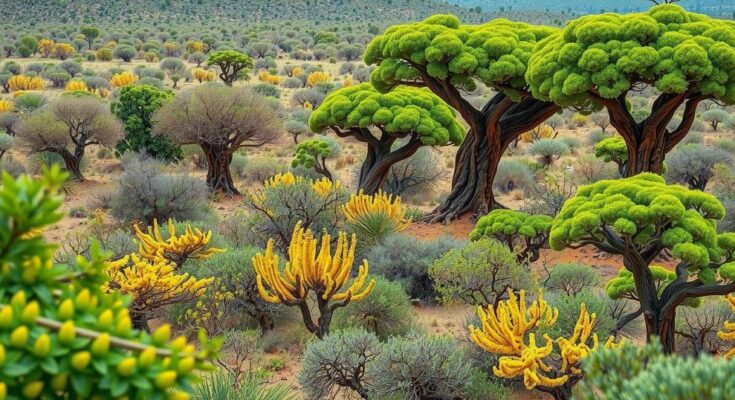Namibia’s dry woodlands hold significant carbon sequestration potential primarily from small trees and shrubs, contributing nearly one-third of the total biomass. Traditional assessments often overlook these plants, leading to underestimations of carbon storage and inadequate policies. This study urges for recognition and inclusion of the entire woodland structure in carbon assessments to safeguard these essential ecosystems and enhance climate action initiatives.
Carbon sequestration is the process wherein vegetation captures and stores carbon dioxide (CO2) from the atmosphere through photosynthesis. This fundamental process transforms CO2 into organic matter, including wood, leaves, roots, and soil carbon, playing a crucial role in combatting climate change. Forests and woodlands are vital in mitigating greenhouse gas emissions, as they store carbon and help to slow the effects of global warming, with large trees storing carbon for extended periods and smaller vegetation maintaining an active carbon cycle.
In examining the carbon storage capabilities within Namibia’s dry woodlands, recent research reveals that small trees and shrubs are significantly more important than previously recognized. This study highlights their substantial contribution of nearly one-third to the total woody biomass in Namibia’s northern and northeastern regions. Excluding these smaller plants from carbon assessments results in a serious underestimation of these ecosystems’ total carbon storage capacity, which has far-reaching implications for conservation, carbon credits, and climate policies.
The findings further illustrate the interdependence of various tree sizes. Large trees affect the growth patterns of smaller species by creating different environmental conditions—open canopies allow for more sunlight to reach shrubs, boosting their biomass contributions, while dense foliage limits smaller plants. Woodland structure, in conjunction with rainfall, significantly influences the carbon storage capabilities of these ecosystems. In drier regions, such as Namibia, open tree cover allows smaller trees and shrubs to play a critical role in carbon sequestration.
Traditional global carbon assessments primarily focus on larger trees, often neglecting those under 5 cm or 10 cm in diameter and based largely on studies from moist forests. This oversight leads to underestimated carbon storage in dry woodlands, limiting funding opportunities for carbon credit programs and resulting in inadequate conservation policies. Enhanced carbon measurement strategies will promote more effective management and protection of these unique ecosystems.
The implications of the study are particularly pertinent to global environmental frameworks and climate policies, including Carbon Credit Markets, the Intergovernmental Panel on Climate Change, and the Reducing Emissions from Deforestation and Forest Degradation programme. These initiatives shape carbon assessments and provide funding for forest conservation. Failing to account for smaller trees undermines the financial benefits that Namibia’s dry woodlands deserve and diminishes their critical role in climate action.
The study advocates for three crucial changes: firstly, the inclusion of small trees and shrubs in carbon assessments to ensure accurate estimations; secondly, recognition of the full carbon storage potential of dry woodlands beyond traditional rainforests; and thirdly, the development of holistic policies that encompass entire woodland structures to optimize carbon storage across all vegetation layers.
As climate change poses increasingly severe threats to forests globally, it is imperative to recognize Namibia’s dry woodlands as vital carbon reserves. Scientists, policymakers, and conservationists must reassess their approaches to measuring and valuing carbon within these ecosystems. By including understorey plants in carbon accounting practices, Namibia stands to benefit substantially from global climate markets, leading to improved conservation strategies and increased international funding for climate action as we strive to protect our environment for future generations.
In summary, Namibia’s dry woodlands harbor significant carbon storage potential that is often overlooked in conventional assessments. Recognizing the contributions of small trees and shrubs is vital for accurate carbon accounting, enhancing conservation efforts, and optimizing funding opportunities for climate action. By evolving our understanding and evaluation of these vital ecosystems, we can better address the pressing challenges posed by climate change while securing financial and ecological benefits for Namibia.
Original Source: www.namibian.com.na




